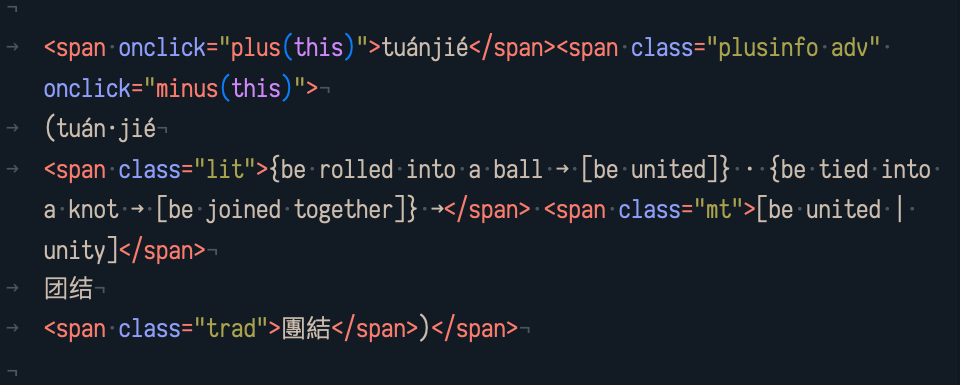New Features: Different Colour for Pīnyīn Plus Literal English Meanings Leading to Effective Meanings, Matching Capitalization Formats
The English meanings provided in Pīnyīn Plus inline “flashcards” can be much richer than the English meanings in past generations of Mandarin-learning material, since with Pīnyīn Plus material, the complete text of the English meanings does not have to be visible all of the time—it can stay out of sight and be not taking up space until you call for it. However, with all that rich information, sometimes including both literal meanings and effective meanings, the Pīnyīn Plus English meanings can sometimes get difficult to parse, or mentally divide into logical, digestible parts.
To make it easier to read and parse the rich Pīnyīn Plus English meanings, a new feature has been introduced that renders literal meanings that lead to effective meanings in a different colour, compared to the usual colour for English meanings. This different colour will have the same hue as the usual colour for English meanings, but it will be lighter, making the indicated material still identifiable as English material, even as it makes it easily distinguishable from the regular English material.
For example, with “yídìng (yí·dìng {(with) one} · {setting fixedly} → [definitely] 一定)”, it can be seen that the literal translations “{(with) one} · {setting fixedly}” lead to an effective meaning of “definitely”.
Pīnyīn Plus expressions in which the literal English meanings are understandable enough as they are will continue to display the English meanings in the usual colour for English meanings. An example of such an expression is “bāngzhù (help 帮助 幫助)”.
The practice of using different colours to distinguish different kinds of text has long been used in Chinese field unofficial language-learning materials, such as the 3-line materials, but this is apparently the first time different kinds of English-language material in such materials are being rendered in different—though related—colours.
Those who work with computer source code, like web developers and app developers, also take advantage of how quickly and easily humans can generally tell different-coloured items apart from one another, by having the different parts of the source code they work with displayed in different colours. That way, that often complex source code can be much more easily made sense of by humans. This practice is called syntax highlighting.

Syntax highlighting example: Some Pīnyīn Plus web page source code involved in rendering the Mandarin expression “tuánjié”
Another change that is being made to improve Pīnyīn Plus material English meanings is that the capitalization formats applied to the English meanings are now being made to match the capitalization formats of the Pīnyīn expressions they are attached to—if the Pīnyīn is all capitals, the English will be all capitals; if the Pīnyīn is in title case, the English will be in title case, etc. (One exception is that the punctuation-motivated capitalization of the first Pīnyīn word of each sentence will not be carried over to its corresponding English meaning, since the English meanings do not include punctuation.)
The above changes to how Pīnyīn Plus material English meanings are rendered will be implemented in all new Pīnyīn Plus material going forward. Existing Pīnyīn Plus material will be revised with these changes as time allows.